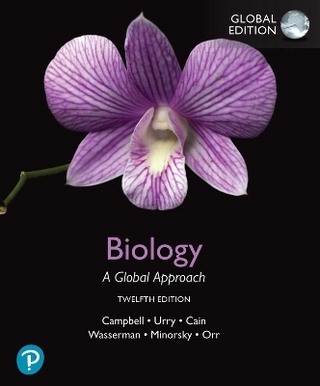
Flow Cytometry with Plant Cells – Analysis of Genes, Chromosomes and Genomes
Wiley-VCH Verlag GmbH (Hersteller)
978-3-527-61092-1 (ISBN)
- Keine Verlagsinformationen verfügbar
- Artikel merken
Targeted at beginners as well as experienced users, this handy reference explains the benefits and uses of flow cytometery in the study of plants and their genomes. Following a brief introduction that highlights general considerations when analyzing plant cells by flow cytometric methods, the book goes on to discuss examples of application in plant genetics, genomic analysis, cell cycle analysis, marine organism analysis and breeding studies. With its list of general reading and a glossary of terms, this first reference on FCM in plants fills a real gap by providing first hand practical hints for the growing community of plant geneticists.
Jaroslav Dolezel is the Head of the Czech Institute of Experimental Botany in Olomouc, and Associate Professor at the Palacky University in Olomouc. He has pioneered the use of flow cytometry in plant science for the analysis of nuclear genome size and regularly holds international training courses on the subject. Johann Greilhuber is Associate Professor at the Institute of Botany at the University of Vienna. He has studied plant genomes for almost 30 years and is an expert on intraspecific variation of genome size. He has constantly been developing novel techniques to study plant genomes, among them many methods based on flow cytometry. Jan Suda heads the laboratory of flow and image cytometry at the Czech Academy of Sciences' Institute of Botany. He is a taxonomist specializing in plant biosystematics, including genome size determination and has co-authored a book on taxonomy analysis.
Preface.List of Contributors.1 Cytometry and Cytometers: Development and Growth (Howard M. Shapiro).Overview.1.1 Origins.1.2 From Absorption to Fluorescence, from Imaging to Flow.1.3 The Growth of Multiparameter Flow Cytometry.1.4 Bench-tops and Behemoths: Convergent Evolution.1.5 Image Cytometry: New Beginnings?References.2 Principles of Flow Cytometry (J. Paul Robinson and Gerald Gregori).Overview.2.1 Introduction.2.2 A Brief History of Flow Cytometry.2.3 Components of a Flow Cytometer.2.4 Flow Cytometric Informatics.2.5 Spectral Compensation.2.6 Cell Sorting.2.7 Calibration Issues.2.8 Conclusions.References.3 Flow Cytometry with Plants: an Overview (Jaroslav Dolezel, Johann Greilhuber, and Jan Suda).Overview.3.1 Introduction.3.2 Fluorescence is a Fundamental Parameter.3.3 Pushing Plants through the Flow Cytometer.3.4 Application of Flow Cytometry in Plants.3.5 A Flow Cytometer in Every Laboratory?3.6 Conclusions and Future Trends.References.4 Nuclear DNA Content Measurement (Johann Greilhuber, Eva M. Temsch, and Joao C. M. Loureiro).Overview.4.1 Introduction.4.2 Nuclear DNA Content: Words, Concepts and Symbols.4.3 Units for Presenting DNA Amounts and their Conversion Factors.4.4 Sample Preparation for Flow Cytometric DNA Measurement.4.5 Standardization.4.6 Fluorescence Inhibitors and Coatings of Debris.4.7 Quality Control and Data Presentation.4.8 Future Directions.References.5 Flow Cytometry and Ploidy: Applications in Plant Systematics, Ecology and Evolutionary Biology (Jan Suda, Paul Kron, Brian C. Husband, and Pavel Travn& acute;cek).Overview.5.1 Introduction.5.2 Practical Considerations.5.3 Applications in Plant Systematics.5.4 Applications in Plant Ecology and Evolutionary Biology.5.5 Future Directions.References.6 Reproduction Mode Screening (Fritz Matzk).Overview.6.1 Introduction.6.2 Analyses of the Mode of Reproduction.6.3 A Recent Innovative Method: the Flow Cytometric Seed Screen.6.4 Flow Cytometry with Mature Seeds for other Purposes.6.5 Conclusions.References.7 Genome Size and its Uses: the Impact of Flow Cytometry (Ilia J. Leitch and Michael D. Bennett).Overview.7.1 Introduction.7.2 Why is Genome Size Important?7.3 What is Known about Genome Size in Plants?7.4 The Extent of Genome Size Variation across Plant Taxa.7.5 Understanding the Consequences of Genome Size Variation: Ecological and Evolutionary Implications.7.6 Methods of Estimating Genome Size in Plants and the Impact of Flow Cytometry.7.7 Recent Developments and the Future of Flow Cytometry in Genome Size Research.References.8 DNA Base Composition of Plant Genomes (Armin Meister and Martin Barow).Overview.8.1 Introduction.8.2 Analysis of Base Composition by Flow Cytometry.8.3 Conclusions.References.9 Detection and Viability Assessment of Plant Pathogenic Microorganisms using Flow Cytometry (Jan H. W. Bergervoet, Jan M. van der Wolf, and Jeroen Peters).Overview.9.1 Introduction.9.2 Viability Assessment.9.3 Immunodetection.9.4 Conclusions and Future Prospects.References.10 Protoplast Analysis using Flow Cytometry and Sorting (David W. Galbraith).Overview.10.1 Introduction.10.2 Results of Protoplast Analyses using Flow Cytometry and Sorting.10.3 Walled Plant Cells: Special Cases for Flow Analysis and Sorting.10.4 Prospects.References.11 Flow Cytometry of Chloroplasts (Erhard Pfundel and Armin Meister).Overview.11.1 Introduction.11.2 Chloroplast Signals in Flow Cytometry.11.3 Progress of Research.11.4 Conclusion.References.12 DNA Flow Cytometry in Non-vascular Plants (Hermann Voglmayr).Overview.12.1 Introduction.12.2 Nuclear DNA Content and Genome Size Analysis.12.3 Future Perspectives.12.4 Conclusion.References.13 Phytoplankton and their Analysis by Flow Cytometry (George B. J. Dubelaar, Raffaella Casotti, Glen A. Tarran, and Isabelle C. Biegala).Overview.13.1 Introduction.13.2 Plankton and their Importance.13.3 Considerations for using Flow Cytometry.13.4 Sampling: How, Where and When.13.5 Monitoring Applications.13.6 Ecological Applications.13.7 Marine Optics and Flow Cytometry.13.8 Future Perspectives.References.14 Cell Cycle Analysis in Plants (Martin Pfosser, Zoltan Magyar, and Laszlo Bogre).Overview.14.1 Introduction.14.2 Univariate Cell Cycle Analysis in Plant Cells.14.3 BrdUrd Incorporation to Determine Cycling Populations.14.4 Cell Cycle Synchronization Methods: Analysis of Cell Cycle Transitions in Cultured Plant Cells.14.5 Plant Protoplasts to Study the Cell Cycle.14.6 Root Meristems for Cell Cycle Synchronization.14.7 Study of Cell Cycle Regulation by using Synchronized Cell Cultures and Flow Cytometry.14.8 Cell Cycle and Plant Development.14.9 Flow Cytometry of Dissected Tissues in Developmental Time Series.14.10 Cell Type-specific Characterization of Nuclear DNA Content by Flow Cytometry.14.11 Other Methods and Imaging Technologies to Monitor Cell Cycle Parameters and Cell Division Kinetics in Developing Organs.14.12 Concluding Remarks.References.15 Endopolyploidy in Plants and its Analysis by Flow Cytometry (Martin Barow and Gabriele Jovtchev).Overview.15.1 Introduction.15.2 Methods to Analyze Endopolyploidy.15.3 Occurrence of Endopolyploidy.15.4 Factors Modifying the Degree of Endopolyploidization.15.5 Dynamics of Endopolyploidization.15.6 Endopolyploidy and Plant Breeding.15.7 Conclusions.References.16 Chromosome Analysis and Sorting (Jaroslav Dolezel, Marie Kubalakova, Pavla Suchankova, Pavl& acute;na Kovarova, Jan Bartos, and Hana Simkova).Overview.16.1 Introduction.16.2 How Does it Work?16.3 How it All Began.16.4 Development of Flow Cytogenetics in Plants.16.5 Applications of Flow Cytogenetics.16.6 Conclusions and Future Prospects.References.17 Analysis of Plant Gene Expression Using Flow Cytometry and Sorting (David W. Galbraith).Overview.17.1 Introduction.17.2 Methods, Technologies, and Results.17.3 Prospects.References.18 FLOWER: A Plant DNA Flow Cytometry Database (Joao Loureiro, Jan Suda, Jaroslav Dolezel, and Conceicao Santos).Overview.18.1 Introduction.18.2 Taxonomic Representation in DNA Content Studies.18.3 Nuclear Isolation and Staining Buffers.18.4 Standardization and Standards.18.5 Fluorochromes.18.6 Quality Measures of Nuclear DNA Content Analyses.18.7 The Uses of DNA Flow Cytometry in Plants.18.8 Instrumentation.18.9 Where Are the Results Published?18.10 Conclusion.References.Index.
| Verlagsort | Weinheim |
|---|---|
| Sprache | englisch |
| Maße | 170 x 240 mm |
| Gewicht | 1061 g |
| Themenwelt | Naturwissenschaften ► Biologie |
| ISBN-10 | 3-527-61092-8 / 3527610928 |
| ISBN-13 | 978-3-527-61092-1 / 9783527610921 |
| Zustand | Neuware |
| Haben Sie eine Frage zum Produkt? |
aus dem Bereich

